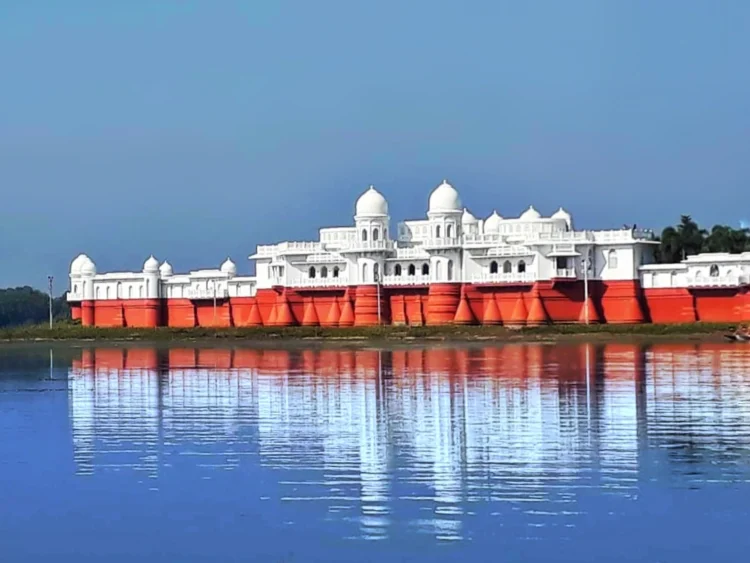Nestled amidst the tranquil waters of Rudrasagar Lake in Melaghar, Tripura, Neermahal stands as a testament to the rich cultural and architectural heritage of India. Built between 1930 and 1938 by Maharaja Bir Bikram Kishore Manikya Bahadur, this magnificent water palace is a unique fusion of Hindu and Muslim architectural styles, showcasing the visionary tastes of its royal patron.
A Historical Marvel
Neermahal, translating to “Water Palace,” was conceived by Maharaja Bir Bikram Kishore Manikya Bahadur as a summer retreat for the royal family. Located approximately 53 kilometers from Agartala, the capital of Tripura, this palace spans Rudrasagar Lake, covering a vast area of scenic beauty. The palace’s construction was overseen by the British company Martin and Burns, which meticulously brought to life the Maharaja’s grand vision of blending traditional Indian elements with influences from Mughal architecture.
Architectural Splendor
The palace is divided into two distinct sections, each serving a unique purpose. The western part, known as Andar Mahal, was reserved exclusively for the royal family. It comprises 24 opulently decorated rooms where the Maharaja and his family once retreated during the scorching summers of Tripura. The intricate carvings, ornate ceilings, and delicate artwork in the Andar Mahal reflect the Maharaja’s penchant for luxury and cultural refinement.
To the east lies an expansive open-air theatre, where the Maharajas hosted vibrant cultural events, including drama, dance performances, and other festivities. This section of Neermahal not only served as a venue for royal entertainment but also as a platform for showcasing the rich cultural heritage of Tripura to visiting dignitaries and guests.
Interior Majesty
Inside Neermahal, visitors are transported back in time as they explore the lavishly adorned chambers and corridors. The palace’s interior boasts intricate woodwork, stained glass windows, and a harmonious blend of Hindu and Islamic motifs that adorn the walls and ceilings. Each room within Andar Mahal tells a story of royal decadence and artistic prowess, offering a glimpse into the opulent lifestyle of Tripura’s erstwhile rulers.
Two grand staircases lead from the interior of Neermahal down to the lake’s edge, where hand-powered boats once ferried the Maharaja and his entourage across Rudrasagar Lake. The palace’s strategic location in the middle of the lake not only ensured privacy and security but also added to its ethereal charm, with the shimmering waters reflecting the grandeur of the structure above.
Cultural Significance
Beyond its architectural magnificence, Neermahal holds profound cultural significance for the people of Tripura. The palace has become a symbol of the region’s rich heritage, embodying centuries-old traditions and customs. Every year in August, the Neermahal Water Festival attracts tourists and locals alike, featuring colourful cultural programmes, boat races, and other traditional festivities that celebrate Tripura’s vibrant cultural tapestry.
Preservation Efforts
Over the years, Neermahal has faced challenges due to neglect and a lack of maintenance. However, efforts by the government of Tripura have been instrumental in preserving this historical gem. Major renovations were undertaken in the late 20th century to restore Neermahal to its former glory, ensuring that future generations can continue to marvel at its architectural splendor.
Today, Neermahal stands as one of India’s best-preserved heritage sites, meticulously maintained by the authorities to showcase Tripura’s cultural richness to the world. The palace not only serves as a tourist attraction but also as a cultural hub where visitors can immerse themselves in the traditions and customs of the region through various cultural programmes and events held throughout the year.
Conclusion
In conclusion, Neermahal remains a beacon of Tripura’s cultural identity and historical legacy. Its stunning architecture, serene surroundings, and rich cultural significance make it a must-visit destination for travellers seeking to explore India’s diverse heritage. As one of the world’s finest examples of water palaces and a testament to the artistic ingenuity of its builders, Neermahal continues to captivate visitors from across the globe.
The efforts of the Government of Tripura to preserve and promote Neermahal underscore its commitment to safeguarding the region’s cultural heritage. By hosting cultural programmes and events at the palace, Tripura not only attracts tourism but also fosters a deeper appreciation for the traditions that have shaped its identity over centuries.
For those who venture to Neermahal, it offers not just a glimpse into history but an immersive experience in the timeless elegance of Indian architecture and the enduring spirit of Tripura’s cultural heritage. As travellers explore its corridors and gaze upon its tranquil waters, they are reminded of the legacy of Maharaja Bir Bikram Kishore Manikya Bahadur and the lasting impact of his vision for a palace that stands as a testament to the beauty of Tripura.


















